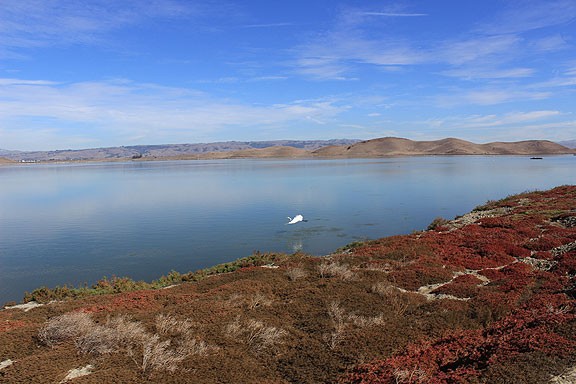
A heron glides across the wetlands off Coyote Hills Regional Park in the south bay, 2014.
“…were civilization itself to be estimated by some of its results, it would seem perhaps better for what we call the barbarous part of the world to remain unchanged.” —Herman Melville, 1846, Typee: A Peep at Polynesian Life
I’m not a “professional” historian—I didn’t go to college to study history, and never even graduated with an undergraduate degree. As a long-ago college dropout I had the freedom to browse topics and follow my curiosity wherever it led me, and now, almost a half century later, I have read a great deal, and know a lot about a lot. But I’m not delusional, and the main lesson of all this history reading, history making, writing, discussing, and presenting, is an acute awareness of how little I know. Knowing a lot and practically nothing at the same time prepared me perfectly for the book I’m going to write about today.
In the past few years, if you’ve been reading this blog, you’ll know that my interests, starting with my early focus on (the stupidity of most) work and (our deteriorating) ecology, generally San Francisco and California-focused, have been turning more broadly to early American history. Especially the histories that have been emerging of indigenous “Americans” in both north and south America (and the horrifying genocides they were subjected to), and the role of Africans who were brought here in slavery, and have been at the heart of continental history ever since. I have been seeking some deeper sense of the continuities that carry those harsh precedents into our current lives. As always I’ve been reading a lot, and had the pleasure and genuine amazement of reading the just-released The Dawn of Everything: A New History of Humanity by David Graeber and David Wengrow (The Davids from here).
I blogged a few posts ago about my pal Annalee Newitz’s fascinating book on Four Lost Cities: A Secret History of the Urban Age, but The Davids have gone considerably further and deeper (and much longer). There are so many different themes that emerge from The Dawn of Everything that it is a challenge to present the book’s topic in any simple summary (like Annalee they take on the question of how and when cities emerged, but they do so much more too). There are parts of this book that I was particularly moved by, especially the gap-filling history of North America between the common idea of migration from Asia at the end of the last Ice Age thousands of years ago to the arrival of Europeans a little over 500 years ago. By unpacking that lost history using solid archaeological and anthropological evidence they debunk our common acceptance of a stadial, or stage-ist, understanding of “civilization”—where we go from cave dwellers to hunting and gathering nomadism to sedentary villages where agriculture develops, followed by mining, and the emergence of hierarchy, power, accounting, etc. and eventually leading to cities, empires, and states (“inevitably” producing the world we’re in today, a globalized concoction of militarized states protecting the concentrated wealth of multinational corporations and their owners, straddling a global population nearing 9 billion)… While all these things happened at different places and different times, The Davids are very convincing at changing the lens, at flipping our focus to look at the thousands of years in which early agriculture (or “play farming” as they cleverly call it) is part of life but doesn’t lead to any of the next steps that are supposedly locked in by the emergence of cultivated grains and domesticated animals.
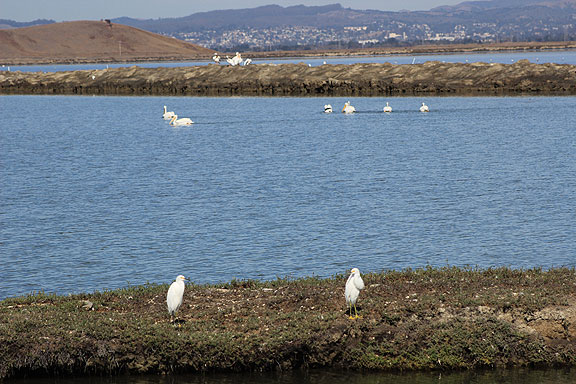
Pelicans and egrets on the still abundant wetlands of the south bay, 2014.
…our remote forager ancestors were much bolder experimenters in social form, breaking apart and reassembling their societies at different scales, often in radically different forms, with different value systems, from one time of year to the next. The festive calendars of the great agrarian civilizations of Eurasia, Africa and the Americas turn out to be mere distant echoes of that world and the political freedoms it entailed.
p. 120
Near the end of the book they re-emphasize one of their main points:
…what happens if we accord significance to the 5,000 years in which cereal domestication did not lead to the emergence of pampered aristocracies, standing armies or debt peonage, rather than just the 5,000 in which it did? What happens if we treat the rejection of urban life, or of slavery, in certain times and places as something just as significant as the emergence of those same phenomena in others? … the periods in which free or relatively free societies existed are hardly insignificant. If you bracket the Eurasian Iron Age (which is effectively what have been doing here), they represent the vast majority of human social experience.
p. 523
The Davids spend a few chapters digging deeply into the history of the cultures that Europeans first encountered in the eastern woodlands of North America. Many people have heard a passing reference to the idea that the US Constitution and governmental structure was inspired in part by the Haudenosaunee Confederation of Six Tribes (commonly referred to as the Iroquois, consisting of Mohawk, Seneca, Cayuga, Onandaga, Oneida, and Tuscarora). But The Davids found a fascinating historical character in a Wendat leader (aka Huron) named Kondiaronk, who was so admired for his oratory and ability to discuss and argue that he was repeatedly invited to dine with the French governor of Montreal in the late 1600s. A lesser French dignitary named Baron Louis Armand Lahontan (1666-1716), who later fell on hard times and was exiled in Amsterdam, witnessed many of Kondiaronk’s public debates and wrote a bestselling book in the early 1700s that The Davids convincingly argue is based on his notes taken from those discussions. Even Wikipedia has posted an excerpt from The Dawn of Everything with this remarkable exchange:
Kondiaronk: I have spent 6 years reflecting on the state of European society and I still can’t think of a single way they act that is not inhuman and I generally think this can only be the case as long as you stick to your distinctions of “mine” and “thine.” I affirm that what you call “money” is the devil of devils, the tyrant of the French, the source of all evils, the bane of souls and slaughterhouse of the living. To imagine one can live in the country of money and preserve one’s soul is like imagining one can preserve one’s life at the bottom of a lake. Money is the father of luxury, lasciviousness, intrigues, trickery, lies, betrayal, insincerity—of all the world’s worst behavior. Fathers sell their children, husbands their wives, wives betray their husbands, brothers kill each other, friends are false—and all because of money. In light of all of this, tell me that we Wyandotte are not right in refusing to touch or so much as look at silver.
Do you seriously imagine that I would be happy to live like one of the inhabitants of Paris? To take two hours every morning just to put on my shirt and make up? To bow and scrape before every obnoxious galoot I meet on the street who happens to have been born with an inheritance? Do you actually imagine I could carry a purse full of coins and not immediately hand them over to people who are hungry? That I would carry a sword but not immediately draw it on the first band of thugs I see rounding up the destitute to press them into Naval service? If on the other hand, Europeans were to adopt an American way of life, it might take a while to adjust but in the end you will be far happier.
Calliére: Try, for once in your life to actually listen. Can’t you see, my dear friend, that the nations of Europe could not survive without gold and silver or some similar precious symbol? Without it, nobles, priests, merchants and any number of others who lack the strength to work the soil would simply die of hunger. Our kings would not be kings. What soldiers would we have? Who would work for Kings or anyone else?
Kondiaronk: You honestly think you’re going to sway me by appealing to the needs of nobles, merchants, and priests? If you abandoned conceptions of mine and thine, yes, such distinctions between men would dissolve. A leveling equality would take place among you, as it now does among the Wyandotte and yes, for the first thirty years after the banishing of self-interest no doubt you would indeed see a certain desolation as those who are only qualified to eat, drink, sleep, and take pleasure would languish and die, but their progeny would be fit for our way of living. Over and over I have set forth the qualities that we Wyandotte believe ought to define humanity: wisdom, reason, equity, etc. and demonstrated that the existence of separate material interest knocks all these on the head. A man motivated by interest cannot be a man of reason.
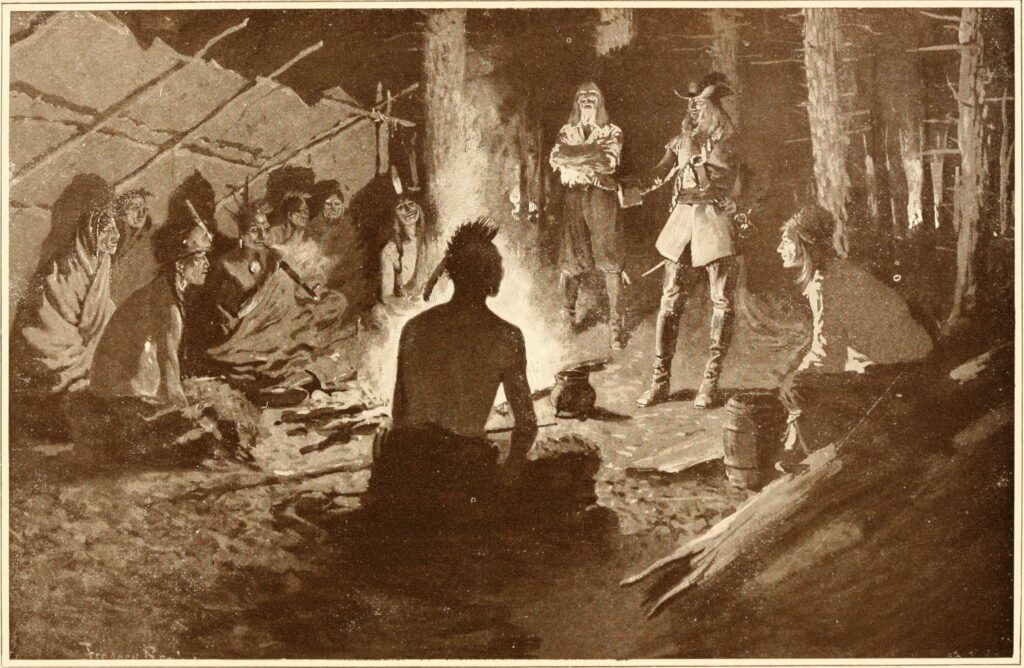
Fanciful rendition of Kondiaronk speaking to captured Iroquois diplomats in 1688. (from Indian history for young folks published in 1919) (from Wikipedia)
This exchange is fascinating in itself. But the authors show that this kind of public debate was made widely known by books published in the early 1700s in Europe. As the years went by, the ideas represented were transformed from arguments made by real humans disgusted by European life into staged dialogues in which the unquestioning Christian interlocutor would be clearly out-argued by his “savage” opponent, but then would end with the knowing shrug that these ideas could only prevail among primitive people who had no better idea. The Davids argue that over some decades this led to the first articulation of the idea of Progress by Turgot in 1750, which was key to dismissing the by then well-known critique of European civilization precisely because the Europeans were self-evidently at the cutting edge of Progress. The French Revolution, based on the new ideas of liberty and individual freedom, mutual aid and the “brotherhood of man,” which was partly instigated by the prevailing new rationalist paradigms of the Enlightenment, can be traced back 100 years to these confrontations between monotheistic, divine-right monarchist Europeans and the divergent, autonomous, consultative, and anti-authoritarian cultures of North America.
But when or how did these cultures develop these attitudes, and how did these political cultures appear? This is where this book is actually very exciting. Cahokia, a city of perhaps 50,000 people at its peak that developed near today’s St. Louis between 900 AD and its eventual collapse around 1350 AD, is key for their argument. While there is evidence of major flooding near the end of Cahokia’s occupation as the largest urban center in North America (until Philadelphia passed it 500 years later), The Davids suggest that the sudden demise of the city has all the earmarks of a social revolution. The large ceremonial mounds that had been the site of human sacrifice and probably served as key legitimation sites for the society’s elite were abruptly abandoned and in some cases destroyed. People depopulated the area and didn’t return for a century, except in small household-size groups.
… what we can say with some confidence is that the societies encountered by European invaders from the sixteenth century onwards were the product of centuries of political conflict and self-conscious debate. They were, in many cases, societies in which the ability to engage in self-conscious political debate was itself considered one of the highest human values.
p. 452
Whatever happened in Cahokia, the backlash against it was so severe that it set forth repercussions we are still feeling today. What we are suggesting is that indigenous doctrines of individual liberty, mutual aid and political equality, which made such an impression on French Enlightenment thinkers, were [not] (as many of them supposed) the way all humans can be expected to behave in a State of Nature… the societies that European settlers encountered, and the ideals expressed by thinkers like Kondiaronk, only really make sense as the product of a specific political history: a history in which questions of hereditary power, revealed religion, personal freedom and the independence of women were still very much matters of self-conscious debate, and in which the overall direction, for the last three centuries at least, had been explicitly anti-authoritarian.
p. 481-482
They are out on a limb here, but what an intriguing one! I love this theme in the book… There are many more. It’s a 530 page book with 200 pages of notes and bibliography, so if you’re drawn to a deep dive into a very accessible synthesis of recent (last 30-40 years) anthropology and archaeology, this is it.
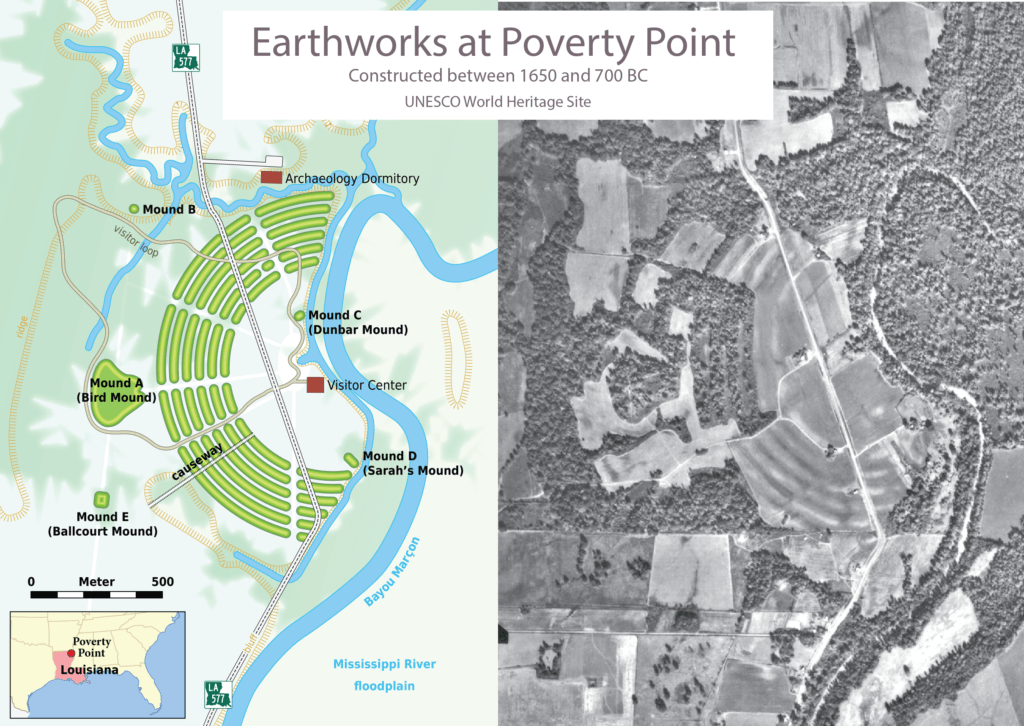
Poverty Point in northern Louisiana is one of the many massive sites that reveal a prehistory of dense human habitation and large-scale projects without the hierarchy and empire-building that has come to be associated with such projects.
I want to insert here another quote I found in Melville’s early novel Typee (1846), where he is living on a south Pacific island as a deserter from a whaling ship. He soon realizes that the people he has found refuge with in a remote island valley are the most feared tribe on the island and are known to be cannibals. He ends up trapped there for months, fearing for his life and scheming a way to escape, but settling in to a bucolic existence surrounded by good food, a beautiful and amorous woman, and mostly great weather. Echoing 150 years later the Huron chief Kondiaronk’s critique of money, he writes:
There none of those thousand sources of irritation that the ingenuity of civilized man has created to mar his own felicity. There were no foreclosures of mortgages, no protested notes, no bills payable, no debts of honor in Typee; no unreasonable tailors and shoemakers, perversely bent on being paid; no duns of any description; no assault and battery attorneys, to foment discord, backing their clients up to a quarrel, and then knocking their heads together; no poor relations, everlastingly occupying the spare bed-chamber, and diminishing the elbow room at the family table; no destitute widows with their children starving on the cold charities of the world; no beggars; no debtors’ prisons; no proud and hard-hearted nabobs in Typee; or to sum up all in one word—no Money! That “root of all evil” was not be found in the valley.
p. 126
Another favorite subtopic The Dawn of Everything presents is the possible role of an even earlier archaeological site at Hopewell (Ohio), where there is evidence dated to the middle of the first millennium among the giant earthen mounds, walls, serpents and shapes that it was a ceremonial gathering place used only 5-6 days a year. The artifacts uncovered in graves there hail from hundreds and thousands of miles away, spanning the continent. It seems that thousands of people would trek to this location annually and engage in some kind of massive ritualized ceremonies that involved both material and cultural exchange. The Davids put this evidence together with a mystery: why, across hundreds of languages and tribal groups in North America, is it common to have in every society a clan structure that takes its name from common animals? How did it happen that across the continent there were Bear, Elk, Hawk, Bison, Fox, etc. clans? The authors conjecture that perhaps it was in the social gatherings of thousands at Hopewell that this system was begun, and its purpose was to create a reliable hosting logic that would provide hospitality to any traveler going from place to place. (In other places in the book they argue that very long-distance travel was far more common in ancient times than we have generally imagined—even trans-Pacific travel was well established thousands of years ago.)
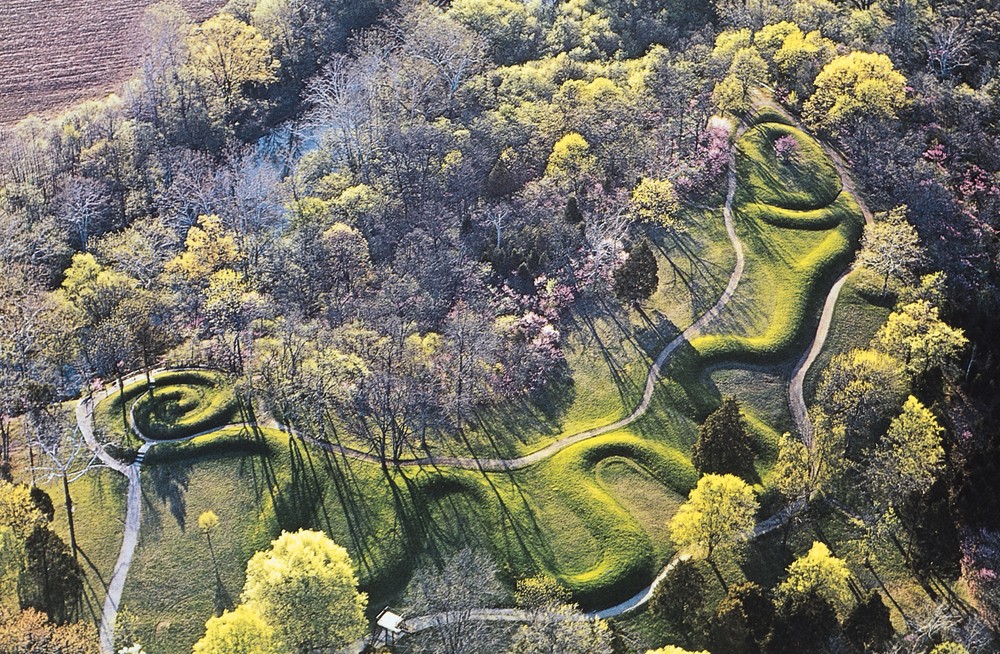
Serpent Mound at Hopewell, Ohio.
Back in the early 1980s a fellow in Zurich, Switzerland wrote a fascinating little book called bolo’bolo. It was written to describe a utopian path forward out of the crises of the old Cold War world that was breaking down in the late 1970s, with its division of the world in First, Second, and Third Worlds. One of the characteristics of a world based on bolos, communities of 500 to 5,000 people, was that every bolo would be expected to have 10% of its beds available to host visitors from afar. Various bolos would develop organic connections across time and space, and an individual traveler could count on a place to stay when they arrived in a far-off land. Now, reading The Dawn of Everything, and its assertion of the origins of the clan structure across North America, I am struck by the parallels when it comes to basic ideas of the freedom to travel, the assumption of hospitality, mutual aid, etc.
Another resonant theme that runs through the book is a primary appreciation of the role of women in both social and technological evolution, as well as in playing key roles in the fluid movements of societies back and forth across different organizational paradigms.
Instead of some male genius realizing his solitary vision, innovation in Neolithic societies was based on a collective body of knowledge accumulated over centuries, largely by women, in an endless series of apparently humble but in fact enormously significant discoveries. Many of these Neolithic discoveries had the cumulative effect of reshaping everyday life every bit as profoundly as the automatic loom or light bulb.
p. 499
To take just two examples, it’s hard to believe that the kind of complex mathematical knowledge displayed in early Mesopotamian cuneiform documents or in the layout of Peru’s Chavín temples sprang fully formed from the mind of a male scribe or sculptor, like Athena from the head of Zeus. Far more likely, these represent knowledge accumulated in earlier times through concrete practices such as the solid geometry and applied calculus of weaving or beadwork. What until now has passed for ‘civilization’ might in fact be nothing more than a gendered appropriation—by men, etching their claims in stone—of some earlier system of knowledge that had women at its center.
p. 433
If we are trying to frame more interesting questions to ask of history, this might be one: is there a positive correlation between what is usually called ‘gender equality’ (which might better be termed, simply, ‘women’s freedom’) and the degree of innovation in a given society?Choosing to describe history the other way around, as a series of abrupt technological revolutions, each followed by long periods when we were prisoners of our own creations, has consequences. Ultimately it is a way of representing our species as decidedly less thoughtful, less creative, less free than we actually turn out to have been. It means not describing history as a continual series of new ideas and innovations, technical or otherwise, during which different communities made collective decisions about which technologies they saw fit to apply to everyday purposes, and which to keep confined to the domain of experimentation of ritual play. What is true of technological creativity is, of course, even more true of social creativity.
p. 501
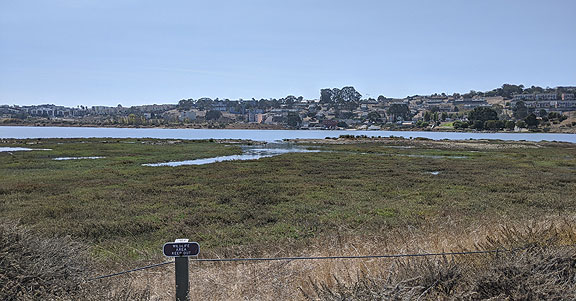
Rich wetlands have come back to life along San Francisco’s southeastern shoreline.
Living in San Francisco, I blogged enthusiastically about James C. Scott’s great Against the Grain where he described the thousands of years of life in the wetlands of Mesopotamia between the Tigris and Euphrates rivers, and how the people there evaded urbanization whenever it suited them. I was struck by the parallels to the diverse and dense populations of Californians who lived around the Bay and in the Delta and Central Valley for thousands of years before the arrival of Europeans. In another recent post, I wrote about Robert Bettinger’s fascinating book about the political and technological evolution of the hunter-gatherer-forager societies of California during the hundreds of years before Spanish colonization (which The Davids cited a lot). Between these two books, now augmented enormously by the syntheses provided by The Davids, we start to get a better sense of how much history in plain sight we’ve been missing all this time. Human life flourished in soggy environments where there was a huge diversity of food sources, but because nearly everything they built or used was also of organic materials, there is much less evidence at first glance of these flourishing civilizations. Certainly the European obsession with sedentary farming as the sine qua non of basic evolution is simply irrelevant to understanding what was going on in California before they arrived. As The Davids put it, “Indigenous peoples of California were not pre-agricultural. If anything, they were anti-agricultural.” (p. 165). And “comprising well-watered soils, annually sifted by river action, and rich wetland and waterside habitats favored by migratory game and waterfowl, such deltaic environments were major attractors for human populations.” (p. 286)
What if we shifted the emphasis away from agriculture and domestication to, say, botany or even gardening? At once we find ourselves closer to the realities of Neolithic ecology, which seems little concerned with taming wild nature or squeezing as many calories as possible from a handful of seed grasses. What it really seems to have been about is creating garden plots—artificial, often temporary habitats—in which the ecological scales were tipped in favor of preferred species. Those species included plants that modern botanists separate out into competing classes of ‘weeds,’ ‘drugs,’ ‘herbs,’ and ‘food crops,’ but which Neolithic botanists (schooled by hands-on experience, not textbooks) preferred to grow side by side. Instead of fixed fields, they exploited alluvial soils on the margins of lakes and springs, which shifted location from year to year. Instead of hewing wood, tilling fields and carrying water, they found ways of ‘persuading’ nature to do much of this labor for them. Theirs was not a science of domination and classification, but one of bending and coaxing, nurturing and cajoling, or even tricking the forces of nature, to increase the likelihood of securing a favorable outcome. Their ‘laboratory’ was the real world of plants and animals, whose innate tendencies they exploited through close observation and experimentation. This Neolithic mode of cultivation was, moreover, highly successful. In the lowland regions of the Fertile Crescent, such as the Jordan and Euphrates valleys, ecological systems of this kind fostered the incremental growth of settlements and populations for three millennia. Pretending it was all just some kind of very extended transition to rehearsal for the advent of ‘serious’ agriculture is to miss the real point. It’s also to ignore what to many has long seemed an obvious connection between Neolithic ecology and the visibility of women in contemporary art and ritual. Whether one calls these figures ‘goddesses’ or ‘scientists’ is perhaps less important than recognizing how their very appearance signals a new awareness of women’s status, which was surely based on their concrete achievements in binding together these new forms of society.
p. 238-239
This book is so much fun to read. Most of the assumptions we’ve carried around since elementary school about teleology, technology, social evolution, civilization, men and women, innovation, Indians, primitive vs. modern, etc. are just blown up by this book. Coming out at this time, as the pandemic grinds on to its probably endemic status, and life is sadly starting to look like it’s going to be more like it was before than any of us had been hoping, this book is like a blast of clean, fresh water, cleansing our minds of cobwebs and inherited biases we have been barely aware of. Take the time to read it. You won’t be sorry!
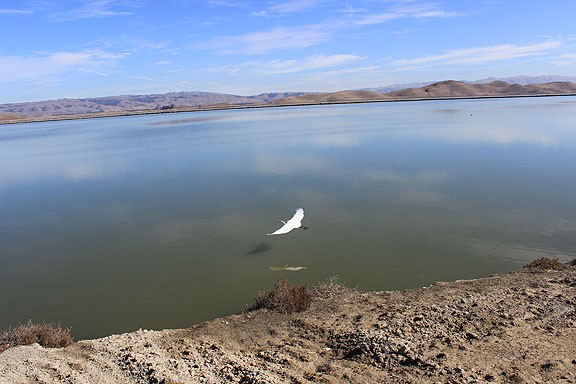
That heron again, over the restored salt ponds at Coyote Hills Regional Park.












As the authors anticipated, the blowback from the mainstream anthro and history academic realms is in full gear. I’m about 2/3’s of the way through and really enjoying it. Ron Sawkolski’s “Gone to Croatan” covers some similar turf, but written even before some of the more recent findings. Reading the book and seeing the blowback reminds me of when I started reading Marja Gimbutas’ archaeological work and how much she was trashed for her “thinking outside” the accepted box of conventional or “received” historical and archaeological wisdom. Along the same lines, I recently read “Cascadia’s Fault” about the Juan de Fuca plate and subduction zone in the PNW that 700 years ago triggered one of the most massive and destructive earthquakes and tsunamis the region (and Japan and other areas on the other side of the Pacific!) had seen, and which will surely happen again, probably (geologically) sooner than later. But the interesting part of the read of that book was its historical overview throughout the book of how various scientists, native American folks, locals, and others, were able to piece the story together over 30 or 40 years, even facing severe backlash from the conventional world of geology, which couldn’t believe that major earthquakes of that scale were possible in that region. Now everyone pretty much takes it for granted, but in the 70s, it was virtually unbelievable, and into the 80s, most people were clueless. Yet here we are. I think that whether or not every historical detail is “true” in the book is not the point. The fact that human society and development is not as simple or linear as industrial and post-industrial capitalism wants to make us believe, thus justifying its “inevitability” at the top of the economic food chain, the story is much more complex, interesting, and diverse, and the possibility of imagining different scenarios and narratives to explain how we got here, that much more urgent, given the “endgame” scenarios we’re now being presented with. #JustLookUp
Another really spot-on and detailed critique of the book is “ALL THINGS BEING EQUAL” by Nancy Lindisfarne and Jonathan Neale, which you have to scroll down to find beneath the first review (which I didn’t like as well) here: https://mronline.org/2021/12/20/the-dawn-of-everything-gets-human-history-wrong/
The one critique I could read (the other is behind some paywall or register kind of thing) destroys the book. Basing an intellectual argument on bullshit is always wrong.
Of course, I’m adamantly opposed to the idea that “humans have the freedom to shape entirely new social realities,” so it really wouldn’t take much for me to reject the book.
I’m going to post an exchange that happened on my Facebook post linked to this blog post… from my friend Dimitri de Morea:
***
I read two separate, high quality reviews of this book. I’ll post them below. The one that appeared recently in the NY Review of Books was quite sympathetic to the book, but it’s ultimately a devastating critique … once you read the details, and the serious and questionable liberties Graeber takes with footnotes and sources (some of them outright dishonest), it’s hard to take this book as a piece of serious scholarship … as anthropological theorizing, or mental jazz-playing, it seems great, but as truly serious and believable scholarship (which is how this book is presented), much less so … And the old problem for people like Graeber is that literally everywhere you look around, starting around 3,500 BCE – whether ancient China, Egypt, Mesopotamia, Greece, Mesopotamia, central america – there is caste, hierarchy, patriarchy and powerful state structures … and caste and oligarchy persisted all the way until the 19th century, literally all around the world – and obviously oligarchy persists to this day (just not by caste but by wealth concentration). But that being said, I’ll still take a real look at the book to examine it a little closer, as I am quite curious (and ignorant) of the stage preceding the Agricultural Revolution … thanks for posting!
***
Here are the links to the reviews:
https://www.nybooks.com/articles/2021/12/16/david-graeber-digging-for-utopia/
and
https://www.persuasion.community/p/a-flawed-history-of-humanity
and my response:
I found the NY Review of Books essay much more compelling and convincing… the Princeton guy more or less repeats the arguments they were critiquing… recreating the house of (European) mirrors where all thinking starts and ends there… but the NYRB guy was much better. Reminded me of what I already knew, that the German peasant revolt of the 1500s was already a dramatically communistic or anarchistic uprising long predating the late 17th and early 18th century (read the novel Q by Luther Blissett for a great account)… so yeah, they wrote this provocative book and lots of people are provoked! That’s a good thing, even if some of their scaffolding falls away and undercuts some of their examples… I’m still happy to endorse this breathtaking rethinking of the distant past, long overdue!
great post chris/ I miss your musings about life / wish you posted more frequently / reading them always expands my understanding of life / have a great holiday season / love ya man / bruster
Brilliant appreciative essay, Chris. I read the book and then read the NYR essay by Appiah, He nails it, as the saying goes.
For me (mea culpa, but after becoming an electrician I then did three graduate degrees in history and cultural anthropology for my sins) The Dawn commits the same logical sins (smile here) that plague (I have to stop this, sorry) works like Jared Diamond’s, and others that I would along with Appiah calls macro historical. And Appiah nicely points out the flaws and fallacies of The Dawn of Everything while also respecting the two co-authors and crediting their inspirational, prophetic one might say, aspirations.
I thoroughly enjoyed the book and found it a bracing romp through the forests of ethnographies past and an engaging, if highly selective for argument’s sake, review of some, but by no means all, writers about what some have called the Whig Interpretation of human history. Appiah is spot on in pointing out the fallacies of how they develop their thesis, including ignoring lots of writers who critiqued inequality from the “Western”, i.e. not “Indigenous” tradition, and I loved how he accurately showed how many of their citations fail to say what they say they said. Reading footnotes vis a vis text is an absolute must with these kinds of works, and G and W’s problems here are often seen in other such thesis-driven “We have finally put things right” claims by authors striving for Originality That Will Shock You.
Bottom line: Graeber and Wengrow have nicely updated the tradition of anarchist critique. I wish David Koven and Audrey Goodfriend, my tutors in all things anarchist when I was still a callow youth, were still here so we could sit down with a good bottle of California Red and regale one another with our takes on Lewis Henry Morgan, the Iroquois Confederation, J.J. Rousseau, Thos. Hobbes, et al vis a vis this splendid new book on What Is To Be Done about the planet and its peoples going forward.
In solidarity,
Bill